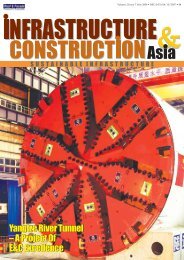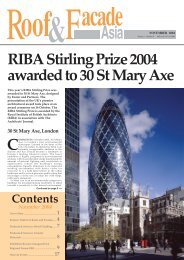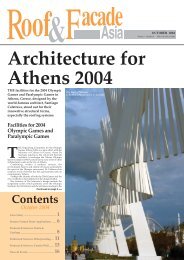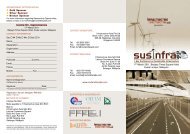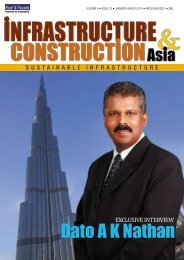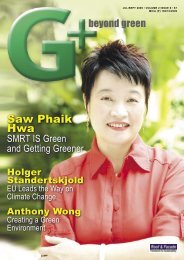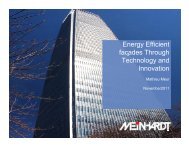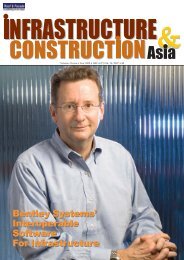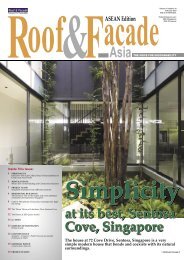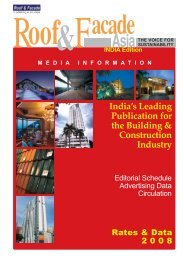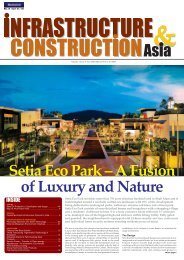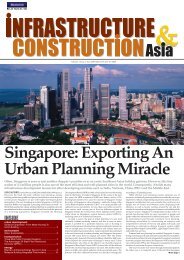Manit Rastogi - Roof & Facade
Manit Rastogi - Roof & Facade
Manit Rastogi - Roof & Facade
Create successful ePaper yourself
Turn your PDF publications into a flip-book with our unique Google optimized e-Paper software.
PANASONIC ROAD SHOW<br />
Panasonic<br />
Mr Ng Meng Hiong, Deputy Director, 3P Partnership<br />
Dept, NEA, and MrIkuo Miyamoto, Managing Executive<br />
<br />
Oceania, holding up the ‘ecodeclaration’ made by Panasonic.<br />
– Committed to<br />
Environmental<br />
Causes<br />
At their eco ideas road<br />
shows in Singapore<br />
Panasonic demonstrates<br />
how it is improving<br />
products to become more<br />
environmentally friendly<br />
while the company works to<br />
reduce its carbon footprint<br />
— but is the company<br />
achieving its objectives<br />
asks Floyd Cowan.<br />
It takes a great deal of work and research to<br />
determine how ‘green’ a company really is,<br />
but with Panasonic, the Japanese electronics<br />
manufacture, it is clear they are not as green as<br />
they would like to be, but what makes Panasonic<br />
different than many companies is that they appear<br />
determined to be more sustainable in all their<br />
operations. No easy task with manufacturing<br />
and distribution facilities around the world. Just<br />
the travel of their executives undoubtedly leaves<br />
a significant carbon footprint.<br />
Reducing CO 2<br />
Emissions<br />
Panasonic tells us they release tons of CO 2<br />
emissions every year — what sets them apart<br />
are their actions to lower and perhaps eventually<br />
eliminate this negative environmental impact.<br />
Mr Ikuo Miyamoto, Managing Executive<br />
Officer, Corporate Management Division<br />
for Asia and Oceania told a gathering at the<br />
launch of their first ‘Eco Ideas’ Road Show in<br />
Singapore that: “ Panasonic will cut 240,000<br />
tons of CO 2<br />
emissions over three years from<br />
April 2007 to March 2010 through more efficient<br />
manufacturing processes. This is the equivalent<br />
to a 30 percent drop from 2006 levels despite<br />
an increase in production volumes.” Panasonic<br />
Asia Pacific has 48 manufacturing sites in seven<br />
countries in the region, which is a key hub for<br />
Panasonic’s global activities.<br />
That is a great deal of CO 2<br />
removed from<br />
entering the atmosphere, but there is still much<br />
more work to be done. Panasonic has committed<br />
money to research to improve what they<br />
create and they are getting the message out to<br />
consumers that they are manufacturing better,<br />
more eco friendly, products.<br />
Creating Awareness<br />
Panasonic’s Road Show was created to not<br />
simply show off their products but to create<br />
more awareness among the public. “Panasonic<br />
has specially created this road show to declare<br />
our ‘eco ideas’ for the region and to raise<br />
people’s awareness on environmental issues<br />
that the world is facing, and to challenge<br />
them to make a personal commitment towards<br />
overcoming these global issues,” Miyamoto<br />
stated.<br />
The Road Show, which opened in Singapore<br />
and will travel to India, Malaysia, Thailand<br />
and other parts of the world, demonstrated<br />
products such as Panasonic’s air conditioners<br />
that send a comfortable air current to each<br />
person in a room by an air current robot which<br />
directs an optimum air current by detecting<br />
the location and movement of a person in<br />
the room, by a sensor. It automatically turns<br />
itself off when the room is unoccupied. In<br />
Singapore, where virtually every building is<br />
air conditioned, this could significantly help<br />
reduce energy consumption.<br />
Experiencing New Technology<br />
The Road Show was created so that people<br />
could experience the technologies and better<br />
understand how each product has been improved<br />
and will help individuals and families reduce<br />
their carbon footprint — and save money and<br />
the world’s resources at the same time.<br />
Water is one area where most people could<br />
do more to reduce their consumption. Panasonic<br />
demonstrated two products that will reduce<br />
household consumption of this precious natural<br />
resource.<br />
The tilted-drum washer/dryer reduces the<br />
water bill and CO 2<br />
emissions every time a load<br />
of laundry is done. It washes with less water<br />
because the drum is tilted in such away as to<br />
maximise the use of water so that less is required<br />
than with a normal drum. When drying clothes it<br />
uses heat pump technology that cuts electricity<br />
cost.<br />
New Materials<br />
When we think of toilets and water use we think<br />
about how to reduce the amount of water when<br />
it is flushed. Panasonic has taken an additional<br />
approach by looking at the material that<br />
bathroom fixtures are made of. Their new stain<br />
resistant material makes cleaning much easier. It<br />
is also scratch-resistant and nice-to-touch. Since<br />
the material stays clean for a long period of time<br />
it reduces the frequency of clean-up, which leads<br />
to saving water. These type of developments will<br />
undoubtedly have applications elsewhere.<br />
While Miyamoto encourages people to “make<br />
their own personal commitments and share<br />
their eco ideas with other people” Panasonic<br />
G+ BEYOND GREEN 26 MAY/ JUNE 2009



